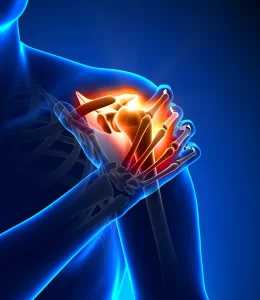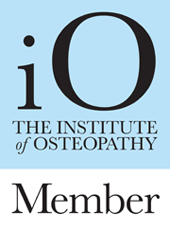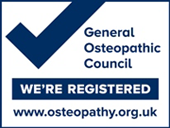Osteopathy & shoulder pain
 Introduction
Introduction
Have you been struggling with shoulder pain for a while? Is it a new complaint after a specific incident? Has it come on gradually for no apparent reason? Does the pain wake you at night? Is it difficult to work with a reduced range of shoulder movement? Have you been forced to stop exercise or a hobby as a result of the pain? We hear you! It is advisable to seek prompt advice from a registered qualified healthcare professional such as an osteopath in order to secure a clear diagnosis and effective treatment plan for your shoulder symptoms.
Background
The shoulder is a ball and socket joint. In order to allow a great range of motion the shoulder needs to sacrifice a degree of stability anatomically. This relative instability sometimes causes damage, especially from overuse or repetitive action injuries.
Causes
There are a number of reasons for shoulder pain, such as:
- Osteoarthritis – degenerative wear and tear in the shoulder joints
- Postural dysfunction – holding the shoulder in a position that causes stress to supporting muscles and results in a combination of neck and shoulder pain
- Frozen shoulder (adhesive capsulitis) – a painful condition that reduces normal movement in the joint (sometimes inhibiting movement in the shoulder altogether)
- Damage to the rotator cuff muscles – a group of supporting muscles that control the shoulder joint and maintain its stability
- Hypermobility of the shoulder instability – here the shoulder may become unstable due to an unusually large range of movement
- Acromioclavicular joint (ACJ) dysfunctions – damage or osteoarthritis at the ACJ, where the collar bone and shoulder blade meet
- Fracture of a bone associated with the shoulder complex, such as the collarbone (clavicle) or upper arm bone (humerus)
- First rib dysfunction – resulting from an overuse injury, poor breathing mechanics or bad posture
- Referred pain from elsewhere – the heart, liver and gallbladder all have the ability to refer pain into the shoulders, so a detailed case history is important to establish if the cause is mechanical or systemic
Treatment
Once a clear diagnosis as to the cause of the shoulder symptoms has been reached, options for treatment with the osteopath can be discussed. Diagnosis is attained via a detailed case history, active and passive examination of the shoulder joint and associated anatomy (e.g. neck, upper ribs), special shoulder tests and, if required, imaging of the shoulder joint.
Patients with shoulder pain often respond well to one or a combination of the following treatments:
- Manual therapy (e.g. Osteopathy)
- Avoiding aggravating activities (e.g. repetitive postures & movements at work, throwing)
- Applying an ice pack at regular intervals (5-10 minutes at a time) for acute symptoms
- Applying a wheatbag or hot water bottle (10 minutes at a time) for chronic symptoms
- Painkillers & anti-inflammatories (e.g. paracetamol, ibuprofen, prescribed diclofenac or naproxen)
- Strengthening exercises for the muscles of the shoulder
- Joint manipulation under anaesthetic for frozen shoulder
- Surgery (if indicated on a scan)
Common presentations
Frozen shoulder (adhesive capsulitis) occurs where there is thickening, swelling and tightening of the capsule surrounding the shoulder joint. Movement is stiff and often very painful. Frozen shoulder pain and symptoms can vary greatly but tend to advance slowly. They are usually felt in three stages, spread over an average of 18 months. Most cases of frozen shoulder occur in people aged over 40. The condition is more common in women than in men.
Tendonitis is inflammation (swelling) of a muscle tendon associated with shoulder movement. Bursitis is inflammation of a bursa (a small, fluid-filled sac usually found over the joints and between tendons and bones). Tendonitis and bursitis often occur together. Impingement syndrome at the shoulder joint involves inflammation and entrapment of the tendons and bursae between the various bones of the joint.
Tendinosis is the weakening and possible tearing of the tendons at the shoulder joint as a result of repeated friction against the shoulder bones. This is common in people over 40. Tears that affect younger people are usually caused by an acute injury. It is estimated that around half of people over the age of 60 may have partial or complete rotator cuff tears. This is because the tendons weaken with age.
Shoulder instability usually occurs in people aged under 35 and can be either traumatic (the shoulder is forced out of place by a sudden impact) or insidious (the shoulder gradually moves out of place over time).
ACJ disorders include:
- Tearing or stretching of the ligaments in the ACJ, often traumatic or from repetitive use
- Partial or complete dislocation of the ACJ from a fall / injury
- Osteoarthritic change to the ACJ through wear and tear
Osteopathic treatment for shoulder pain
Once diagnosed via a detailed case history, careful active and passive assessment of the joint including special tests as applicable, osteopathic treatment of shoulder pain focuses on:
- Reducing pain and inflammation at the shoulder joint and surrounding joints (e.g. neck, upper back, ACJ)
- Improving the range of movement of the shoulder joint and surrounding joints
- Addressing the patient’s posture
- Addressing the patient’s aggravating factors
- Discussing a clear management plan
- Prescribing a set of achievable and effective rehabilitation exercises
Contact us
Our experienced team at Woburn Osteopaths diagnoses and treats a wide range of shoulder symptoms on a daily basis. We will aim to find you an appointment quickly and offer a professional service to diagnose and treat your shoulder discomfort.
Please use our online booking service to make an appointment or call us on 01525 290615 if you would prefer to speak to someone in person or wish to secure some initial advice.


